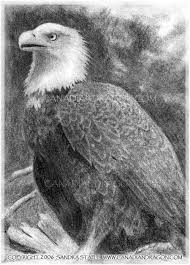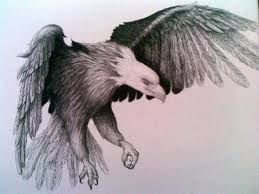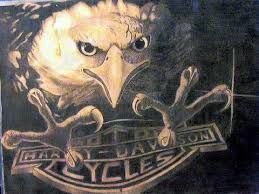Source:Goolge.com.pk
Eagle Pencil Drawings Biography
“I’d like to paint until I’m 90. It’s a privilege,” says Barry Oretsky, underscoring the steadfast commitment to his art that began at a very young age. Oretsky was born in Owen Sound, Ontario on Georgian Bay in 1946, but at age three, his family moved to a neighborhood in downtown Toronto. There, the young Oretsky was sent to an orthodox yeshiva where art was forbidden. In spite of this prohibition advocated by both his school and family, Oretsky announced his decision to become an artist at thirteen, provoking intense disapproval on all sides. He subsequently attended Toronto’s Central Technical High School, earning a Commercial Art diploma in 1965, and then immediately left for London’s prestigious St. Martins School of Art where he’d been accepted into the post-graduate painting program.
From his earliest years as a painter, Oretsky worked as a pastel portraitist at the Canadian National Exhibition, a summer event similar to a large scale state fair in the US, with exhibitions and entertainment venues. Portraits in Pastel was one of the regular vendors at the Exhibition and Oretsky notes that he routinely produced between 500 and 1000 portraits per year for some twenty years; it provided enough supplemental income to allow him to travel and paint.
After leaving St. Martins in 1966, Oretsky traveled to Florence, Italy, where he helped with the rescue efforts for the disastrous flooding that threatened to destroy many of the city’s renaissance treasures. From there, he continued on to Israel where he lived first on a kibbutz and later in Tel Aviv. The years in Israel were formative both professionally and personally. In 1968, he became the youngest artist ever to have a painting accepted into the distinguished Canadian Biennial of Contemporary Art in Winnipeg; and he enlisted in the Israeli Army. His experience in the military introduced him to the grimness of war, but also to his future wife, another North American living in Israel.
In 1970, Oretsky moved back to Toronto where he earned his Permanent Teacher’s Certificate at the College of Education, University of Toronto, and began teaching art at a local secondary school. Three years later, the Oretskys returned to Israel as immigrants, settling in Hod Hasharon outside of Tel Aviv in 1973. It was during these years that Oretsky abandoned his earlier abstract painting and became a realist. While teaching for three years art at Haifa University, he focused his own study on the use of color and technique in realist painting.
Within three years, Oretsky was back in Canada, working as the Head of the Art Department at Thornhill Secondary School where he remained until 1986. A family vacation visit to the National Gallery of Art in Washington, D. C. in 1982, however, proved to be a major turning point in his work. After seeing an exhibition on Orientalist painting, he comments: “I started to hyperventilate. This was the kind of realism I wanted to paint.” He quickly realized that he “didn’t want to emulate anybody. I needed to work from my own photography so that the imagery would be my own.” He soon became a dedicated photographer, shooting many images that might later provide inspiration for his compositions.
Although the mid-1980s were professionally productive, these years were also personally troubling as Oretsky’s marriage fell apart. The mood changed in 1986 when he reluctantly agreed to have coffee with a woman that a friend wanted him to meet. He and Paula married a few years later, eventually moving into her parents’ home and enlarging it to accommodate their new extended family. Oretsky describes Paula as his “besheret”, the Hebrew term for soul mate, saying “everything depends on her faith in me.” Paula not only encouraged Oretsky to focus completely on his art, but took the initiative to send slides of his work to ten major galleries in New York City. The result was that he was invited to exhibit at three different venues in 1987 and his career began moving forward rapidly.
Since then, Oretsky has continued to work full-time as a painter, traveling often and exhibiting regularly. A year-long stay in Aix-en-Provençe in 1991 offered an opportunity to study both urban and rural environments in southern France and northern Italy, as well as the subtleties of reflected light. His fascination with reflection remains a central element in his work, creating a dialogue of light and shadow within the paintings that encourages viewers to develop a narrative about the image. For Oretsky, his paintings are part of a perpetually evolving conversation between past and present that he calls the “art continuum”, mirroring the joy of life in the form of visual narratives. As he remarks, “There are no restrictions on entering the image. The narrative should resonate and connect with the viewer because of its relevance.”
Elected to Royal Canadian Academy of Art in 2004, Oretsky today is a well respected and admired painter. In recent years, the scale of his canvases has expanded significantly, with many of his paintings now as large as 7’ x 5’. Most of these works are commissioned by private patrons who work with him to establish the subject matter in the early stages of the project; Oretsky asks his patrons to select ten images from a vast array of choices as the initial starting point for the composition. This approach not only integrates the client into the process of painting, but also emphasizes the celebration of collaboration and creativity.








Eagle Pencil Drawings Biography
“I’d like to paint until I’m 90. It’s a privilege,” says Barry Oretsky, underscoring the steadfast commitment to his art that began at a very young age. Oretsky was born in Owen Sound, Ontario on Georgian Bay in 1946, but at age three, his family moved to a neighborhood in downtown Toronto. There, the young Oretsky was sent to an orthodox yeshiva where art was forbidden. In spite of this prohibition advocated by both his school and family, Oretsky announced his decision to become an artist at thirteen, provoking intense disapproval on all sides. He subsequently attended Toronto’s Central Technical High School, earning a Commercial Art diploma in 1965, and then immediately left for London’s prestigious St. Martins School of Art where he’d been accepted into the post-graduate painting program.
From his earliest years as a painter, Oretsky worked as a pastel portraitist at the Canadian National Exhibition, a summer event similar to a large scale state fair in the US, with exhibitions and entertainment venues. Portraits in Pastel was one of the regular vendors at the Exhibition and Oretsky notes that he routinely produced between 500 and 1000 portraits per year for some twenty years; it provided enough supplemental income to allow him to travel and paint.
After leaving St. Martins in 1966, Oretsky traveled to Florence, Italy, where he helped with the rescue efforts for the disastrous flooding that threatened to destroy many of the city’s renaissance treasures. From there, he continued on to Israel where he lived first on a kibbutz and later in Tel Aviv. The years in Israel were formative both professionally and personally. In 1968, he became the youngest artist ever to have a painting accepted into the distinguished Canadian Biennial of Contemporary Art in Winnipeg; and he enlisted in the Israeli Army. His experience in the military introduced him to the grimness of war, but also to his future wife, another North American living in Israel.
In 1970, Oretsky moved back to Toronto where he earned his Permanent Teacher’s Certificate at the College of Education, University of Toronto, and began teaching art at a local secondary school. Three years later, the Oretskys returned to Israel as immigrants, settling in Hod Hasharon outside of Tel Aviv in 1973. It was during these years that Oretsky abandoned his earlier abstract painting and became a realist. While teaching for three years art at Haifa University, he focused his own study on the use of color and technique in realist painting.
Within three years, Oretsky was back in Canada, working as the Head of the Art Department at Thornhill Secondary School where he remained until 1986. A family vacation visit to the National Gallery of Art in Washington, D. C. in 1982, however, proved to be a major turning point in his work. After seeing an exhibition on Orientalist painting, he comments: “I started to hyperventilate. This was the kind of realism I wanted to paint.” He quickly realized that he “didn’t want to emulate anybody. I needed to work from my own photography so that the imagery would be my own.” He soon became a dedicated photographer, shooting many images that might later provide inspiration for his compositions.
Although the mid-1980s were professionally productive, these years were also personally troubling as Oretsky’s marriage fell apart. The mood changed in 1986 when he reluctantly agreed to have coffee with a woman that a friend wanted him to meet. He and Paula married a few years later, eventually moving into her parents’ home and enlarging it to accommodate their new extended family. Oretsky describes Paula as his “besheret”, the Hebrew term for soul mate, saying “everything depends on her faith in me.” Paula not only encouraged Oretsky to focus completely on his art, but took the initiative to send slides of his work to ten major galleries in New York City. The result was that he was invited to exhibit at three different venues in 1987 and his career began moving forward rapidly.
Since then, Oretsky has continued to work full-time as a painter, traveling often and exhibiting regularly. A year-long stay in Aix-en-Provençe in 1991 offered an opportunity to study both urban and rural environments in southern France and northern Italy, as well as the subtleties of reflected light. His fascination with reflection remains a central element in his work, creating a dialogue of light and shadow within the paintings that encourages viewers to develop a narrative about the image. For Oretsky, his paintings are part of a perpetually evolving conversation between past and present that he calls the “art continuum”, mirroring the joy of life in the form of visual narratives. As he remarks, “There are no restrictions on entering the image. The narrative should resonate and connect with the viewer because of its relevance.”
Elected to Royal Canadian Academy of Art in 2004, Oretsky today is a well respected and admired painter. In recent years, the scale of his canvases has expanded significantly, with many of his paintings now as large as 7’ x 5’. Most of these works are commissioned by private patrons who work with him to establish the subject matter in the early stages of the project; Oretsky asks his patrons to select ten images from a vast array of choices as the initial starting point for the composition. This approach not only integrates the client into the process of painting, but also emphasizes the celebration of collaboration and creativity.
Eagle Pencil Drawings
Eagle Pencil Drawings
Eagle Pencil Drawings
Eagle Pencil Drawings
Eagle Pencil Drawings
Eagle Pencil Drawings
Eagle Pencil Drawings
Eagle Pencil Drawings
Eagle Pencil Drawings
Desert Eagle Sketch
Let's Draw: Golden Eagle
No comments:
Post a Comment